Florida gars are a pre-historical fish native to Florida and Southern Georgia. They are well known for their alligator-like head and elongated body.
While not as big as Alligator gar, these fish also grow more significantly than average fish, making them monster fish species in the Florida waters.
Florida gars are popular as game fish because of their struggles on the line. Though not as exciting as alligators, catching these fish with rod and reel is also an equally thrilling experience.
In this article, we will share interesting facts and information about Florida gar.
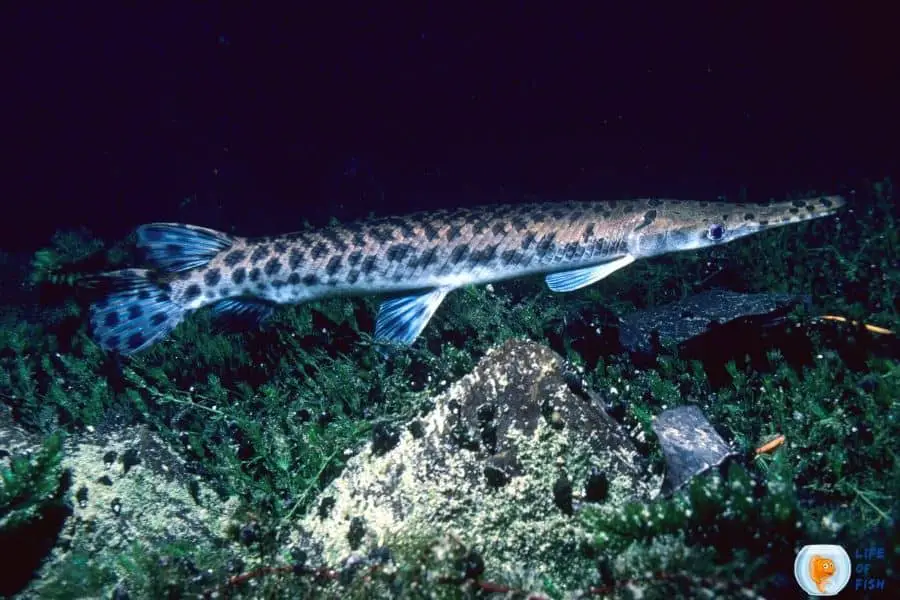
What is Florida Gar?
Jump To
- 1 What is Florida Gar?
- 2 How Florida Gar looks like
- 3 Where Florida Gar live?
- 4 What does Florida Gar eat?
- 5 Florida Gar behavior
- 6 Florida Gar breeding
- 7 Importance of Florida Gar
- 8 Florida Gar vs. Spotted Gar
- 9 Florida Gar Predators
- 10 Florida Gars in Aquariums
- 11 Can you eat Florida Gar?
- 12 What happens if you eat gar eggs?
- 13 Related Question
- 14 Conclusion
In scientific circles, it is known as Lepisosteus platyrhincus. The Florida gar is one of the four recognized species in the genus Lepisosteus.
The other three are Lepisosteus oculatus (Spotted gar), Lepisosteus platostomus(Shortnose gar) and Lepisosteus osseus(Longnose gar).
They are one of the United State’s native gar species. They only live in Florida and Southeastern Georgia.
These fish are distributed around rivers such as Ochlockonee, Savannah, and Georgian watershed.
They are often mistaken for longnose gar and spotted gar. People also mistake them for Atlantic needlefish and Chain pickerel.
But, if you observe these fish carefully, you will see distinct differences in each species.
How Florida Gar looks like
They are primitive species of fish that has a characteristic broad snout and long body. These fish are not as large as alligator gar but grow to be much larger than the average fish.
Color
They have an olive-brown body with dark spots speckled all over its body. These spots are irregular-sized, consistent, and distributed throughout the body, from the top of the head to the anal fin.
Size
The average length of this fish is about 2 to 4 feet. However, the biggest Florida gar ever recorded was 52 inches long. The typical weight of these fish is about 1.36 to 4.36 kg.
Shape
They have a long toothy snout with an elongated torpedo-shaped body and a rounded tail. The scales on the body are diamond-shaped to offer protection against predators.
Life span
The lifespan of this fish is still unknown. However, based on other species of the same genus, Florida gar may live up to 8-12 years.
Male and female fish
Female gars usually grow bigger than males. But, it is generally not possible to tell any differences between male and female unless when they spawn.
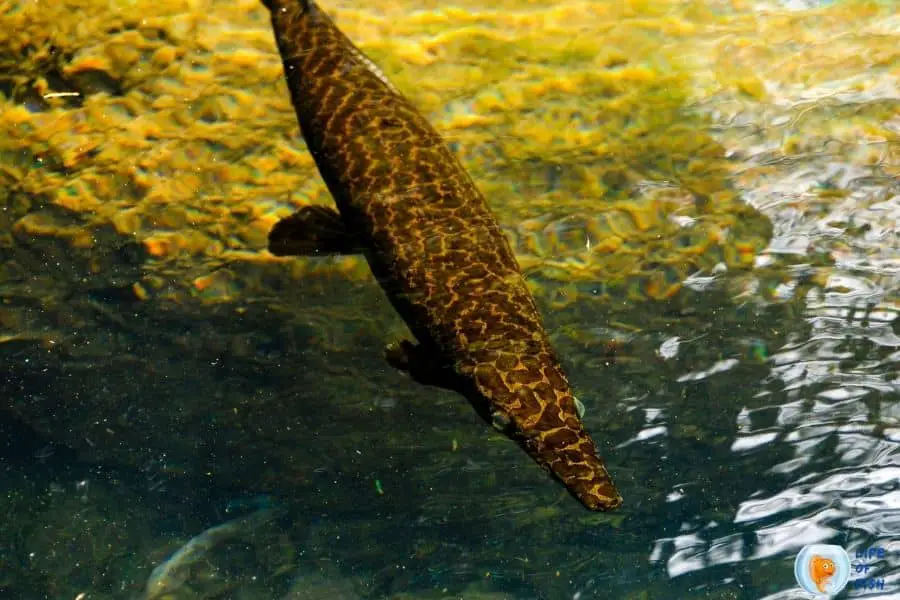
Where Florida Gar live?
They are abundant in Ocklockonee River drainage, Savannah River drainage, and Georgian watershed, which are distributed around Florida and Georgia.
They inhabit lakes that have mud or sand bottoms with dense vegetation, medium to large lowland streams, and canals. You can find them often in medium to shallow waters.
These fish can live in low oxygenated waters like other gar species because they have a unique ability to breathe atmospheric air.
When the water is low on oxygen, they will gulp air from the water’s surface and use it for breathing with their swim bladder’s help.
You can sometimes find these fish on the edge of weeds, hiding behind the weeds, about 6 to 10 inches below the water’s surface. The bottom of these areas will be about 10 feet or more.
What does Florida Gar eat?
They are ambush predators. They usually lie and wait for unsuspecting prey. These predatory fish feed on small aquatic organisms like shrimp, insects, frogs, and other fishes.
When hunting for food, they lunge and strike with speed and precision.
Young Florida gars feed on insect larvae, zooplankton, and small fish. These fish are opportunistic feeders that sit and wait until the prey swims past them.
They often float on the surface of the water, disguising themselves as a stick or log.
The unsuspecting prey comes near their snout, and the gar immediately snaps them with their mouth. Then, they slowly reposition the fish to swallow their head first.
Florida Gar behavior
They are known for their hunting behavior. They are nocturnal predators and mainly piscivores.
These fish are ambush predators that sit and wait for their prey to come near to ambush them.
They use their elongated snout to snag their prey. The prey is then transported into the mouth and swallowed head first.
They are probably more active in the early mornings or late afternoons. You can often see them come to the water’s surface and gulp air, presumably to get more oxygen.
During the dry season, they retreat to marshes they occupy and aestivate.
Aestivation, like hibernation in other species, lowers a gar’s metabolic rate. The ability to withstand high temperatures and arid conditions of their habitats throughout the summer is aided by these adaptations.
Florida Gar breeding
These fish spawn once a year during February and March. They spawn in groups in shallow, weedy waters, and they are egg-laying fish.
When they spawn, the females deposit more than 6000 adhesive eggs on the aquatic plants, and several males fertilize them.
These eggs are highly toxic to mammals, fish, and birds. It takes about 3 to 9 days for the eggs to hatch.
The young fish use their disc-shaped adhesive organ placed on the end of their snouts to stay attached to the plants until they grow up to 2cm in length.
Male gars undergo a reduction in their reproductive capabilities throughout the summer after spawning in the late winter and early spring.
After spawning, hormone levels and gonad maturation will be reduced in the male fish.
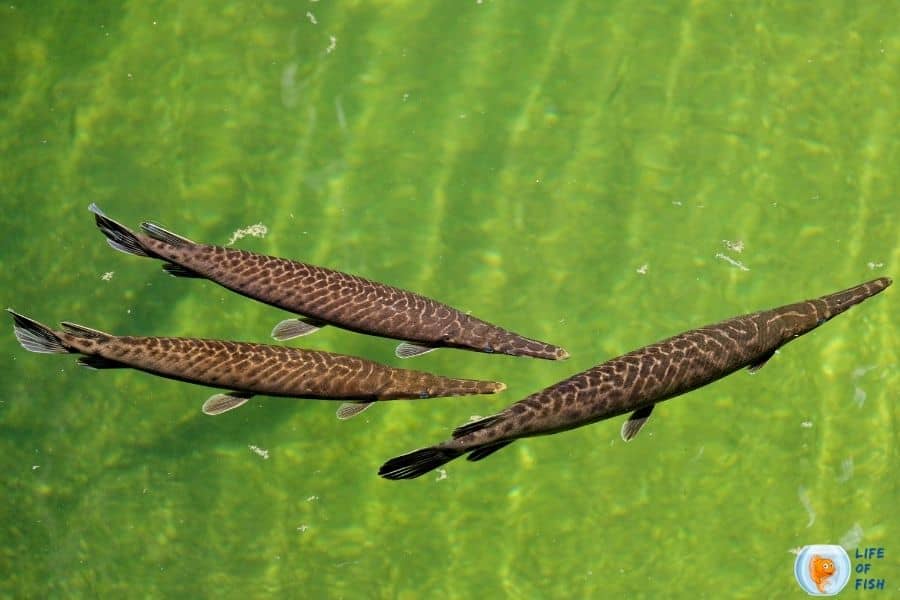
Importance of Florida Gar
Ecosystem balance
They are essential in their ecosystem because they are one of the apex predators. As well as being a predator, they are also prey for other animals like alligators, crocodiles, and some large birds.
Sportfishing
They are also popular as game fish like any other gar species because of their fighting capabilities. They are not easy to catch, and anglers need patience and skill when fishing for Florida gars.
Aquariums
They can also be found in public aquariums due to their captivating look. However, they are not ideal pets for home aquariums because of their massive size and large tank requirements.
As a food
Although these fish are edible, they are not popular as food. There is no market for Florida gar’s flesh. They are only caught because people want to catch a fish.
Florida Gar vs. Spotted Gar
It is difficult to tell apart Florida gar from Spotted gar because both species have an almost similar appearance. However, there are distinct differences between these fish.
They have consistent spots on its body, while the spots in Spotted gar are not consistent.
The spots of Spotted gar are concentrated to the back of the body. But the spots in Florida gar are scattered all over its body.
Spotted gar has a longer and more pointed snout than Florida gar.
The distance between the front of the eye and the rear of the gill cover is shorter in comparison to the snout’s size in Florida gar.
The spotted gar has a greater distance between the eyes and the gills than its relative, Florida gar.
Other than physical differences, the habitats of both species are also different. Spotted gars are often found in the Devil River in Texas, Mexico, and Florida’s lower Apalachicola River.
Florida gars are often found in Ochlockonee and Savannah rivers and Georgian watershed.
So, you can be sure that it is a Spotted gar if you find it from the Apalachicola River. If you find one in the Florida peninsula, it will most likely be a Florida gar.
Florida Gar Predators
Although these fish are apex predators in the water system, they also have predators. Their predators are mainly shorebirds like bald eagles, osprey, and blue herons.
When wetlands recede, they gather in large numbers to areas that remain water. When this happens, they get exposed to the water surface.
Birds take advantage of these gatherings and predate on Florida gars. According to reports, about 75% of the gar population became prey to shorebirds and other predators like American Alligators during this period.
Adult fish have armor-like scales and sharp teeth to defend against predators so that adults can save themselves most of the time.
However, as juvenile gar has not developed the armor-like scales and sharp teeth yet, they make easy prey for predators.
The roe of Florida gars usually stays protected because they are toxic to mammals and birds.
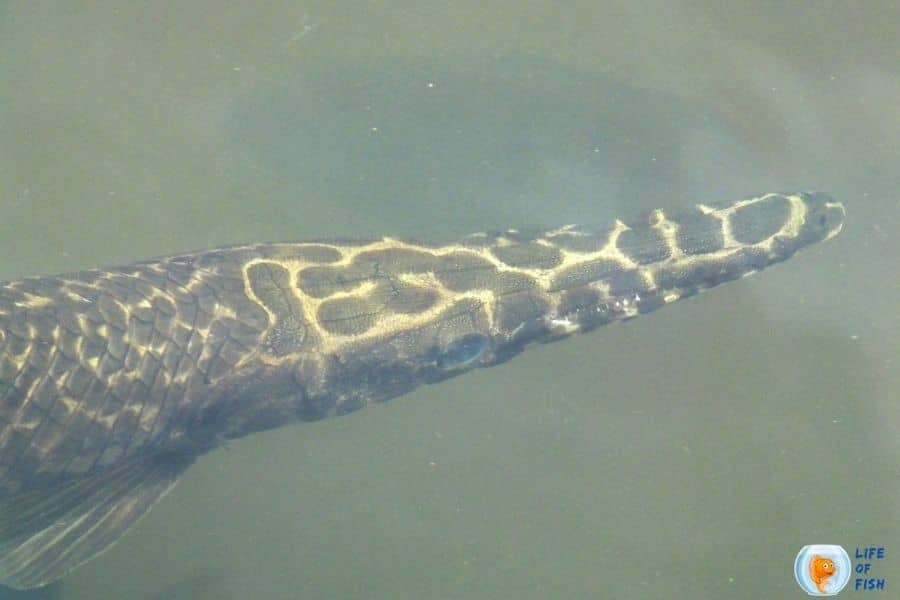
Florida Gars in Aquariums
They are medium-sized gar that usually grows up to 36 inches in length. They do not grow massive like Alligator gars.
So, they are an ideal option for aquarium displays. However, you need to have a tank of more than 300 gallons for an adult Florida gar.
You can keep baby Florida gars in tanks as small as 50 gallons, but you will have to transfer them to much larger aquariums as they grow up.
Florida gars in aquariums are not impossible if you have enough space for an aquarium sized as a public aquarium.
Like many other fish species, they also prefer their natural habitats in aquarium setups, ideally with sand substrate, dense vegetation, and medium to low water currents.
They will do fine with moderate lightings and will need a powerful filtration in the unit.
Florida gars in aquariums are semi-aggressive species that get along well with other large fish species with peaceful or semi-aggressive temperaments.
They will be aggressive with other large, aggressive species like Peacock Bass, Flowerhorns, or Managuense cichlids.
If you house small fish species, they should be small enough not to register as food for these fish. Otherwise, all small fish species will get eaten by Florida gars.
With most carnivore fish, aquarists face problems with feedings as fish expect live food for feedings.
But, that’s not the case with Florida gars. They have a strong appetite and will accept any meaty food like fish, prawns, shrimp, or crickets in captivity.
Special tips
It’s important to know that these fish grow fast and need more food than many other large aquarium fish.
You will also have to change the tank often if you keep them at home. That is why these fish are not recommended for home aquaria, as they grow fast, need more food and more space.
Can you eat Florida Gar?
Yes. You can safely eat the flesh of Florida gar. Florida gars are considered trash fish, and often fishers get rid of them by cutting them away.
However, they are edible fish that have a taste like an alligator flesh but with the texture of chicken.
They are not flaky and don’t have a fishy flavor either. Because of this odd taste, they don’t have any demand among the consumers.
What happens if you eat gar eggs?
Gar eggs (roe) contain a protein-based toxin called ichthyotoxin.
This toxin can cause severe itching, rash, dryness of the mouth and throat, nausea, vomiting, and stomach cramps.
It also causes respiratory problems and can eventually lead to death. So, it is better if you don’t eat roe of garfish.
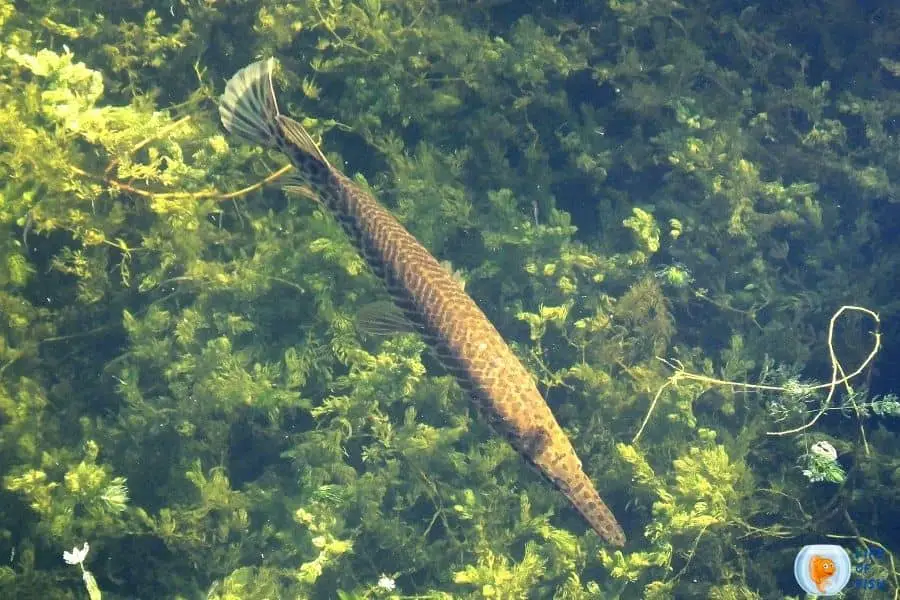
Related Question
What kind of fish is a Florida Gar?
Florida gar is one of the seven species of the gar family. They are fish that look like the prehistoric fish that roamed the earth about 200 million years ago.
These fish are indigenous to the United States, and they are found only in Florida and Georgia.
Are Florida Gars rare?
Florida gars are not rare and abundant in the rivers of Ochlockonee and Savannah, Georgian watershed, and throughout peninsular Florida.
They are listed as Least Concerned in the IUCN Red List due to their wide distribution in their natural habitats.
Do Florida gars have teeth?
Yes. The Florida Gar has a short, broad snout with only one row of irregularly spaced sharp teeth on its upper and lower jaws. This fish uses its teeth to implant and hold the prey.
Can Florida Gar attack a human?
Yes, Florida gar has sharp teeth, and they will use them when they catch something. However, there are no records of attacks on humans by garfish.
Are Florida Gars poisonous?
Florida gars are not poisonous and actually edible. However, their eggs (roe) are toxic to people and many animals like fish and birds.
Conclusion
Florida gars are interesting garfish that live only in Florida and Georgian waters. They have an alligator-like body and can survive in low oxygenated waters.
They are prehistoric fish popular among anglers for sport fishing. Florida gars are edible but considered trash fish because their taste is not great. The roe of Florida gars is toxic to humans, mammals, fish, and birds.
Read Next : Gars Tank Mates | Few Other Fish Who Can Live With Aggresive Gars |
Read Next : Where Do Alligator Gars Live? | 9 Doubts You Should Clarify |
Read Next : Alligator Gar Size | 9 Interesting Facts You Must Know |
